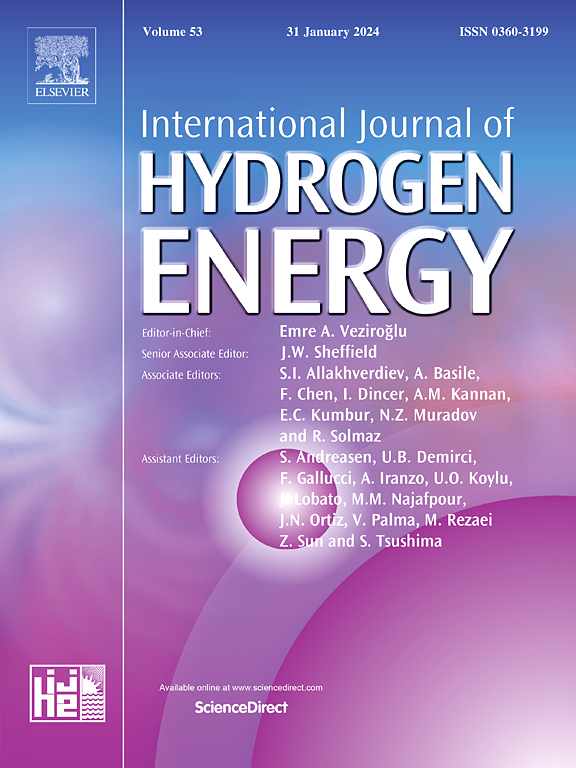PEMFC堆内温度分布优化:冷却板和冷却剂动力学的计算研究
IF 8.1
2区 工程技术
Q1 CHEMISTRY, PHYSICAL
引用次数: 0
摘要
单个PEMFC的显著温度梯度和不同单元之间的温度不均匀性严重影响了实际PEMFC堆叠的性能,甚至寿命。为了获得更好的PEMFC堆内温度分布,本文基于配置结构和冷却剂动力学对验证模型的影响,对PEMFC冷却板的配置和堆的流形高度进行了优化。研究发现,冷却剂速率的增加使冷却板表面和膜上的温度更加一致。除了具有单个蛇形通道的冷却板外,其他五种设计在电池压降小于800时实现了最低水平的温度不一致性。混合蛇形通道(V-I)设计的一致性最好。随着堆内电流的增加,热量增加,近似于指数增长,电流密度的增加增大了膜与冷却板之间的温差。在6种冷却板设计中,V-I冷却板的温度分布最为一致,有利于燃料电池堆寿命的延长。当歧管高度降低时,所有歧管中的冷却液速度都增加。更高的流形高度会导致更明显的电池一致性改善。在冷却水流量较低时,单个冷却板之间的变化对冷却效果的影响更为明显。在所有冷却板设计的通道中,在恒压降下,单蛇形设计下的层流变化最小。相反,V-I设计在较低的工作压力下表现出最佳的一致性。本文章由计算机程序翻译,如有差异,请以英文原文为准。
Optimizing temperature distribution in a PEMFC stack: A computational study on cooling plate and coolant dynamics
The performances, even the lifespan, of an actual PEMFC stack are seriously influenced by the significant temperature gradient in the single PEMFC and the temperature inhomogeneity among different units of PEMFC. To obtain better temperature distribution within the PEMFC stack, the cooling plate configuration of PEMFC and the manifold height of the stack have been optimized based on the impacts of configuration structure and the coolant dynamics in the present article upon validated models. The study found that the coolant rate increase made the temperature more consistent across the cooling plate's surface and the membrane. Except for the cooling plates with a single serpentine channel, the other five designs achieved their lowest level of temperature inconsistency at a cell pressure drop of less than 800. The mixed serpentine channel (V–I) design showed the best consistency. As the electric current in the stack goes up, the heat increases, which approximates exponential growth, and the increase in current density enlarges the temperature difference between the membrane and the cooling plate. Among the six cooling plate designs, the V–I cooling plate showed the most consistent temperature distribution, which is good for the fuel cell stack's lifespan. When the manifold height decreases, the coolant speed in all manifolds increases. A higher manifold height leads to a more noticeable improvement in cell consistency. The impact of the variation between single cooling plates is more evident at low cooling water flow rates. Among all the channels in the cooling plate designs, stacks under the single serpentine design showed the lowest variations at a constant pressure drop. Conversely, the V–I design showed the best consistency at lower operating pressures.
求助全文
通过发布文献求助,成功后即可免费获取论文全文。
去求助
来源期刊

International Journal of Hydrogen Energy
工程技术-环境科学
CiteScore
13.50
自引率
25.00%
发文量
3502
审稿时长
60 days
期刊介绍:
The objective of the International Journal of Hydrogen Energy is to facilitate the exchange of new ideas, technological advancements, and research findings in the field of Hydrogen Energy among scientists and engineers worldwide. This journal showcases original research, both analytical and experimental, covering various aspects of Hydrogen Energy. These include production, storage, transmission, utilization, enabling technologies, environmental impact, economic considerations, and global perspectives on hydrogen and its carriers such as NH3, CH4, alcohols, etc.
The utilization aspect encompasses various methods such as thermochemical (combustion), photochemical, electrochemical (fuel cells), and nuclear conversion of hydrogen, hydrogen isotopes, and hydrogen carriers into thermal, mechanical, and electrical energies. The applications of these energies can be found in transportation (including aerospace), industrial, commercial, and residential sectors.
 求助内容:
求助内容: 应助结果提醒方式:
应助结果提醒方式:


